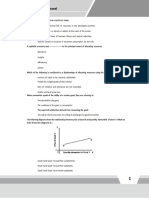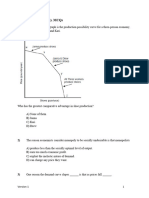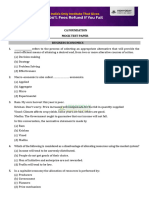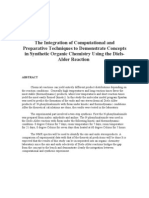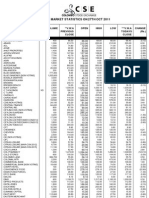0 ratings0% found this document useful (0 votes)
68 viewsPreparatory Course in Economics Microeconomics of Product Markets Quiz 2
Preparatory Course in Economics Microeconomics of Product Markets Quiz 2
Uploaded by
Misha KazimirovThis document provides a quiz for a microeconomics course on product markets. It contains 15 multiple choice questions covering topics like price elasticity of demand, indifference curves, production costs, and cost curves. The questions assess understanding of key microeconomic concepts relating to consumer behavior, production, and costs.
Copyright:
© All Rights Reserved
Available Formats
Download as PDF, TXT or read online from Scribd
Preparatory Course in Economics Microeconomics of Product Markets Quiz 2
Preparatory Course in Economics Microeconomics of Product Markets Quiz 2
Uploaded by
Misha Kazimirov0 ratings0% found this document useful (0 votes)
68 views5 pagesThis document provides a quiz for a microeconomics course on product markets. It contains 15 multiple choice questions covering topics like price elasticity of demand, indifference curves, production costs, and cost curves. The questions assess understanding of key microeconomic concepts relating to consumer behavior, production, and costs.
Original Title
ACFrOgAS4ZGsDh_H_BsN8aIIWj0r36AX2ftVN3A6V6HAuJX4SaXHlpUhe71Dl66pNp74dpK62aYc-BQDPuz7eutnuWYOHMX0SJ6lnieZpuSRAVFp5fzkIDiMgUirmoA8qPhAKwY-RDOciJYPShFp.pdf
Copyright
© © All Rights Reserved
Available Formats
PDF, TXT or read online from Scribd
Share this document
Did you find this document useful?
Is this content inappropriate?
This document provides a quiz for a microeconomics course on product markets. It contains 15 multiple choice questions covering topics like price elasticity of demand, indifference curves, production costs, and cost curves. The questions assess understanding of key microeconomic concepts relating to consumer behavior, production, and costs.
Copyright:
© All Rights Reserved
Available Formats
Download as PDF, TXT or read online from Scribd
Download as pdf or txt
0 ratings0% found this document useful (0 votes)
68 views5 pagesPreparatory Course in Economics Microeconomics of Product Markets Quiz 2
Preparatory Course in Economics Microeconomics of Product Markets Quiz 2
Uploaded by
Misha KazimirovThis document provides a quiz for a microeconomics course on product markets. It contains 15 multiple choice questions covering topics like price elasticity of demand, indifference curves, production costs, and cost curves. The questions assess understanding of key microeconomic concepts relating to consumer behavior, production, and costs.
Copyright:
© All Rights Reserved
Available Formats
Download as PDF, TXT or read online from Scribd
Download as pdf or txt
You are on page 1of 5
Preparatory course in Economics
Microeconomics of Product Markets
Quiz 2
Deadline: 16/02/2020 at 23:59
1. Suppose the price of local cable TV serviсe increased from $16.20 to $19.80 and as a result the
number of cable subscribers decreased from 224,000 to 176,000. Along this portion of the
demand curve, price elasticity of demand is:
A) 0.8.
B) 1.2.
C) 1.6.
D) 8.0
Use the following to answer question 2
2. Suppose that the above total revenue curve is derived
from a particular linear demand curve. That demand
curve must be:
A) inelastic for price declines that increase
quantity demanded from 6 units to 7 units.
B) elastic for price declines that increase quantity
demanded from 6 units to 7 units.
C) inelastic for price increases that reduce quantity
demanded from 4 units to 3 units.
D) elastic for price increases that reduce quantity
demanded from 8 units to 7 units.
3. Which of the following generalizations is not correct?
A) The larger an item is in one's budget, the greater the price elasticity of demand.
B) The price elasticity of demand is greater for necessities than it is for luxuries.
C) The larger the number of close substitutes available, the greater will be the price elasticity of
demand for a particular product.
D) The price elasticity of demand is greater the longer the time period under consideration.
4. An antidrug policy which reduces the supply of heroin might:
A) increase street crime because the addict's demand for heroin is highly inelastic.
B) reduce street crime because the addict's demand for heroin is highly elastic.
C) reduce street crime because the addict's demand for heroin is highly inelastic.
D) increase street crime because the addict's demand for heroin is highly elastic.
5. The shift of the budget line from cd to ab in the above figure is consistent with:
A) decreases in the prices of both M and N .
B) an increase in the price of M and a decrease in the price of N . C) a decrease in money
income.
D) an increase in money income.
6. At each point on an indifference curve:
A) money income is the same.
B) the prices of the two products are the same.
C) total utility is the same.
D) marginal utility is the same.
7. An indifference map implies that:
A) money income is constant, but the prices of the two products vary directly with the quantities
purchased.
B) the two products under consideration are perfectly substitutable for one another.
C) a consumer is better off to be at some point high on a given curve as opposed to a point low
on the same curve.
D) curves farther from the origin yield higher levels of total utility.
8. Which of the following is correct?
A) Budget lines are linear and upsloping; indifference curves are downsloping and concave to
the origin.
B) Budget lines are linear and downsloping; indifference curves are downsloping and concave to
the origin.
B) Budget lines are linear and downsloping; indifference curves are downsloping and convex to
the origin.
D) Budget lines are downsloping and convex to the origin; indifference curves are linear and
downsloping.
9. Which of the following is most likely to be an implicit cost for Company X?
A) depreciation charges on company-owned equipment
B) rental payments on IBM equipment
C) payments for raw materials purchased from Company Y
D) transportation costs paid to a nearby trucking firm
10. Which of the following statements concerning the relationships between total product (TP),
average product (AP), and marginal product (MP) is not correct?
A) AP continues to rise so long as TP is rising.
B) AP reaches a maximum before TP reaches a maximum.
C) TP reaches a maximum when the MP of the variable input becomes zero.
D) MP cuts AP at the maximum AP.
Use the following to answer questions 6-7
11. Refer to the above diagram, where variable inputs of labor are being added to a constant
amount of property resources. The total output of this
firm will cease to expand:
A) if a labor force in excess of Q1 is employed.
B) if a labor force in excess of Q2 is employed.
C) if a labor force in excess of Q3 is employed.
D) only if the marginal product curve becomes negative
at all levels of output.
12. Refer to the above diagram, where variable inputs of labor are being added to a constant
amount of property resources. Average variable cost will be at a minimum when the firm is
hiring:
A) Q3 workers.
B) Q2 workers.
C) Q1 workers.
D) more than Q3 workers.
13.
In the above figure, curves 1, 2, 3, and 4 represent the:
A) ATC, MC, AFC, and AVC curves respectively.
B) AFC, MC, AVC, and ATC curves respectively.
C) MC, ATC, AVC, and AFC curves respectively.
D) ATC, AVC, AFC, and MC curves respectively.
14. Total fixed cost (TFC):
A) falls as the firm expands output from zero, but eventually rises.
B) falls continuously as total output expands.
C) varies directly with total output.
D) does not change as total output increases or decreases.
15. Which of the following curves is not U-shaped?
A) MC
B) AFC
C) AVC
D) ATC
You might also like
- MPO Assignment 1 (02000539)Document13 pagesMPO Assignment 1 (02000539)Aarkash Kannangara0% (1)
- ADL 04 Managerial Economics V3Document6 pagesADL 04 Managerial Economics V3solvedcare100% (1)
- Eco Difficult & Tricky MCQDocument23 pagesEco Difficult & Tricky MCQritubhattar8No ratings yet
- Practicequestions Final Econ301 2022Document15 pagesPracticequestions Final Econ301 2022reetNo ratings yet
- Eco Difficult & Tricky MCQ With AnswersDocument29 pagesEco Difficult & Tricky MCQ With Answersritubhattar8No ratings yet
- Econ AllDocument14 pagesEcon Alllnqnhu0902No ratings yet
- ECO Test 1Document9 pagesECO Test 1Dilpreet Singh MendirattaNo ratings yet
- Theories Ms FinalsDocument6 pagesTheories Ms FinalscaraisabelacaliaoNo ratings yet
- Extra Multiple Choice Questions For Review: Chapter 20: Demand and Supply: Elasticities and ApplicationsDocument6 pagesExtra Multiple Choice Questions For Review: Chapter 20: Demand and Supply: Elasticities and Applicationskami_shahNo ratings yet
- Econs Past QuaestionsDocument50 pagesEcons Past QuaestionsYaw AcheampongNo ratings yet
- 120 Ex 1Document6 pages120 Ex 1Gileah ZuasolaNo ratings yet
- Aditional Problems MCQ SupplydemandDocument19 pagesAditional Problems MCQ SupplydemandHussein DarwishNo ratings yet
- 40 % MENDATARY OF Micro Economics - BDocument6 pages40 % MENDATARY OF Micro Economics - BBalochNo ratings yet
- ECON 1550 Sem 2 Session 20082009Document12 pagesECON 1550 Sem 2 Session 20082009regoleNo ratings yet
- Microeconomics Mock-Exam V1Document11 pagesMicroeconomics Mock-Exam V1phuonguyennn17No ratings yet
- Mock Test Paper 3 - 28052024 Update On 29052024Document16 pagesMock Test Paper 3 - 28052024 Update On 29052024nvneha9498No ratings yet
- Baims-1644406705 13 MLF Altmaryn PDFDocument5 pagesBaims-1644406705 13 MLF Altmaryn PDFShahadNo ratings yet
- EC1002 Examiner CommentariesDocument17 pagesEC1002 Examiner CommentariesBryan Sing100% (1)
- Final Without Answers133Document12 pagesFinal Without Answers133mariamtata21jkNo ratings yet
- 2020 Micro Test 3Document5 pages2020 Micro Test 3Bornface WiseNo ratings yet
- Quiz 6BDocument2 pagesQuiz 6BAli Shaharyar ShigriNo ratings yet
- Solution Excel 2DDocument6 pagesSolution Excel 2DSooHan MoonNo ratings yet
- Econ 1101 Microeconomics I: The University of New South Wales School of EconomicsDocument12 pagesEcon 1101 Microeconomics I: The University of New South Wales School of EconomicsJohn ReedNo ratings yet
- Sadia Saeed EconomicsDocument15 pagesSadia Saeed Economicssadia saeedNo ratings yet
- Micro Chapter 18 Practice Problems 2 KeyDocument4 pagesMicro Chapter 18 Practice Problems 2 KeyThigilpandi07 YTNo ratings yet
- Httpslearn Eu Central 1 Prod Fleet02 Xythos - Content.blackboardcdn - Com63ce84988f7ea231536x Blackboard S3 Bucket Learn Eu CeDocument15 pagesHttpslearn Eu Central 1 Prod Fleet02 Xythos - Content.blackboardcdn - Com63ce84988f7ea231536x Blackboard S3 Bucket Learn Eu Cealaamabood6No ratings yet
- Economics QuestionsDocument17 pagesEconomics Questionsshamnaafsal21No ratings yet
- Demand and Supply Elasticity 1Document6 pagesDemand and Supply Elasticity 1boornoNo ratings yet
- 5 6228697555618758765Document16 pages5 6228697555618758765Sachin DixitNo ratings yet
- More Multiple Choice Questions With AnswersDocument14 pagesMore Multiple Choice Questions With AnswersJudz Sawadjaan100% (2)
- Chapter 4-Elasticity Practice QuestionsDocument6 pagesChapter 4-Elasticity Practice QuestionsTrung Kiên Nguyễn100% (1)
- Use The Demand Curve Diagram Below To Answer The Following QuestionDocument6 pagesUse The Demand Curve Diagram Below To Answer The Following Questionnishant haweliaNo ratings yet
- ECO2144 Micro Theory I 2007 Final ExamDocument5 pagesECO2144 Micro Theory I 2007 Final ExamTeachers OnlineNo ratings yet
- Ec1002 EqpDocument8 pagesEc1002 Eqpruibin0518No ratings yet
- Econ 222 Final Exam ReviewDocument15 pagesEcon 222 Final Exam ReviewJenayl MillerNo ratings yet
- PaperDocument5 pagesPapernisarg_No ratings yet
- Exercise 3Document9 pagesExercise 3raj jeevanNo ratings yet
- ECO415 Tutorial Chapter 3Document8 pagesECO415 Tutorial Chapter 3Izzul Mirwan Che Ab. RahimNo ratings yet
- HUL212 MODERN MICROECONOMICS - IIT Delhi - Minor-1 - Engineering - Year-2008 - 106Document3 pagesHUL212 MODERN MICROECONOMICS - IIT Delhi - Minor-1 - Engineering - Year-2008 - 106Sachin BatwaniNo ratings yet
- Tutorial 4 - May 2021Document8 pagesTutorial 4 - May 2021Tester McTestingtonNo ratings yet
- CA Foundation ECO & BCK Q MTP 2 Nov23 Castudynotes ComDocument17 pagesCA Foundation ECO & BCK Q MTP 2 Nov23 Castudynotes Comnavyabearad2715No ratings yet
- Eco All Chap MCQDocument523 pagesEco All Chap MCQRadhaNo ratings yet
- A6 May 2023Document5 pagesA6 May 2023marymeela24No ratings yet
- Answer: ADocument7 pagesAnswer: AusjaamNo ratings yet
- Ec101, Test A Instructions: Answer Questions 1-12 On The Left-Hand Margin Without Skipping LinesDocument2 pagesEc101, Test A Instructions: Answer Questions 1-12 On The Left-Hand Margin Without Skipping LinesLuke MadzikotoNo ratings yet
- EconomicDocument131 pagesEconomicsibirajsibiraj50No ratings yet
- CA Foundation Business Eco Q MTP 2 June 2024 Castudynotes ComDocument17 pagesCA Foundation Business Eco Q MTP 2 June 2024 Castudynotes Comabbasiarmaan2No ratings yet
- Spring Final Test 2022 (Questions) v1.1Document8 pagesSpring Final Test 2022 (Questions) v1.1rozinskiy.serNo ratings yet
- Econ1003 201718 01 Econ1003w1Document14 pagesEcon1003 201718 01 Econ1003w1khushi TripathiNo ratings yet
- Practice MCQ Ch3Document11 pagesPractice MCQ Ch3ahmedfeqi0% (1)
- Econ1001 2017/18 01Document14 pagesEcon1001 2017/18 01khushi TripathiNo ratings yet
- University: BotswanaDocument4 pagesUniversity: BotswanaThabo ChuchuNo ratings yet
- Econ 102 S 07 FXDocument11 pagesEcon 102 S 07 FXhyung_jipmNo ratings yet
- CH 6 Quiz SGDocument5 pagesCH 6 Quiz SGWill HughesNo ratings yet
- Managerial Economics Question BankDocument21 pagesManagerial Economics Question BankM.Satyendra kumarNo ratings yet
- Economics and BCK QUESTION PAPERDocument8 pagesEconomics and BCK QUESTION PAPERnashwauefaNo ratings yet
- Tutorial #1 With AnswersDocument10 pagesTutorial #1 With AnswersregoleNo ratings yet
- Micro 1Document15 pagesMicro 1M KNo ratings yet
- Public Finance Answers To Final Exam Practice Questions Autumn 2017Document6 pagesPublic Finance Answers To Final Exam Practice Questions Autumn 2017elhamNo ratings yet
- Elasticity of DD & SS PDFDocument10 pagesElasticity of DD & SS PDFIshan bhardwajNo ratings yet
- Imperfect Markets and Imperfect Regulation: An Introduction to the Microeconomics and Political Economy of Power MarketsFrom EverandImperfect Markets and Imperfect Regulation: An Introduction to the Microeconomics and Political Economy of Power MarketsNo ratings yet
- Diel Alder ReportDocument7 pagesDiel Alder Reportjnane200650% (2)
- WP Winning at Home Delivery 1Document12 pagesWP Winning at Home Delivery 1kshemaNo ratings yet
- Instructions - Digital PlannerDocument11 pagesInstructions - Digital PlannerMohamad FikreeNo ratings yet
- SriMathaIsUniversalMother DescrptionDocument3 pagesSriMathaIsUniversalMother DescrptionAnonymous VdXFPOvGxNo ratings yet
- Transformer Stations and Renewable Energy Equipment Res 2023Document72 pagesTransformer Stations and Renewable Energy Equipment Res 2023delmarlauranNo ratings yet
- Project Report On Shopping ApplicationDocument118 pagesProject Report On Shopping ApplicationpassionatepriyaNo ratings yet
- Royal Dutch Shell PLC Case Study AS GeoDocument12 pagesRoyal Dutch Shell PLC Case Study AS Geothejanitor16100% (1)
- AP Psychology Chapter Nine UnitDocument84 pagesAP Psychology Chapter Nine UnitJonaLee FellerNo ratings yet
- Atoms and MoleculesDocument5 pagesAtoms and MoleculesDilip Kumar KumawatNo ratings yet
- Child and Adolescent Quiz With AnswerDocument22 pagesChild and Adolescent Quiz With AnswerChi ChayNo ratings yet
- PHYSICS IMPORTANT PROBLEMS 2nd PucDocument12 pagesPHYSICS IMPORTANT PROBLEMS 2nd Pucwarriorhitesh48No ratings yet
- United States v. Samuel Desist, Frank Dioguardi, Jean Claude Lefranc, Jean Nebbia and Anthony Sutera, 384 F.2d 889, 2d Cir. (1967)Document23 pagesUnited States v. Samuel Desist, Frank Dioguardi, Jean Claude Lefranc, Jean Nebbia and Anthony Sutera, 384 F.2d 889, 2d Cir. (1967)Scribd Government DocsNo ratings yet
- Office of The OmbudsmanDocument6 pagesOffice of The OmbudsmantintyiNo ratings yet
- Islamiyat CSS SallybusDocument3 pagesIslamiyat CSS Sallybusiqbal.junaid9991No ratings yet
- 2018 - Open - Adrienne Chambon PDFDocument20 pages2018 - Open - Adrienne Chambon PDF金仁皓No ratings yet
- Komatsu Hybrid Nat Niqa Nov 2011 PDFDocument14 pagesKomatsu Hybrid Nat Niqa Nov 2011 PDFRafael Viegas100% (1)
- Course Guide or L 2013Document6 pagesCourse Guide or L 2013Asebaho BadrNo ratings yet
- Staff Nurse GR II HSD SLDocument5 pagesStaff Nurse GR II HSD SLviraltrendslive123No ratings yet
- New Trend Maths ChapterDocument32 pagesNew Trend Maths ChapterAaron MokNo ratings yet
- Ujian Praktikum FarmasiDocument2 pagesUjian Praktikum Farmasipolma12No ratings yet
- Etd1161 20110721165628Document276 pagesEtd1161 20110721165628Ouerdia Ait yahiaNo ratings yet
- 1757 08-10 Gelatamp ENDocument4 pages1757 08-10 Gelatamp ENStevishaNo ratings yet
- Sept 2023 InviteDocument17 pagesSept 2023 InvitevhczuluNo ratings yet
- Shale Gas Unconventional Gas Summit Brochure - CRDocument9 pagesShale Gas Unconventional Gas Summit Brochure - CRSherry Cheng RuiNo ratings yet
- Writing U6 WorksheetDocument3 pagesWriting U6 WorksheetmauNo ratings yet
- Price List 1Document4 pagesPrice List 1LBTodayNo ratings yet
- Dream YogaDocument57 pagesDream Yogatheonlyraiden100% (1)
- Richmond County Property Transfers Sept. 12 - 18Document4 pagesRichmond County Property Transfers Sept. 12 - 18augustapressNo ratings yet
- Era of Disposable WorkersDocument2 pagesEra of Disposable WorkersUmair Ahmed33% (3)




